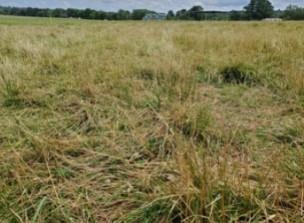By Ryan McGeeney
With autumn just around the corner, ranchers and pasture managers should consider a few actions that can extend the grazing season, making the best of the available forage base until next spring.

THREE-PART PLAN — Novel endophyte tall fescue field mid-July in Northwest Arkansas. This field should be clipped with a bushhog to around 4 inches before nitrogen fertilizer for stockpiling should be applied. (Image courtesy Dirk Philipp.)
Dirk Philipp, associate professor of animal science for the University of Arkansas System Division of Agriculture, said that with the ongoing summer heat, cool season perennials such as tall fescue are still showing signs of heat stress and reduced overall growth.
“But this will quickly change as night-time temperatures fall during the coming weeks and cool season perennial forages start growing again, albeit at a reduced rate compared to spring,” Philipp said. “In the meantime, there are several things landowners can do to maximize the growth and health of their pastures.”
These steps include adequate fertilization, stockpiling forage and ensuring adequate grazing.
Fertilization
When it comes to tall fescue, Philipp said, fertilization recommendations tend to diverge, with some experts proposing that producers fertilize only in the fall, fall or spring (but not both), or even late fall.
“It all depends on the landowner’s situation,” Philipp said. “But any time after Sept. 1 can be justified as we enter overall cooler conditions that help cool season grasses thrive.”
Recommended rates are around 50-60 pounds of nitrogen per acre. Urea fertilizer may volatilize somewhat before being dissolved by rain, Philipp said, so it’s theoretically best to watch the forecast and wait for a shower, depending on the fertilizer being used.
“In practice, however, this is difficult to achieve,” Philipp said. “The best might be to develop the practice of applying nitrogen at consistent target times each year based on the specific needs of the land, considering factors such as current and historic weed pressure, soil conditions and the condition of the forage stand.”
Stockpiling
When stockpiling forage for later use in the fall and winter, Philipp points to the standard practice of applying fertilizer to accelerate the growth of tall fescue for later use.
“Apply about 60 pounds of nitrogen per acre during the first weeks of September to your fields,” Philipp said. “Canopies should be relatively short to ensure fresh regrowth from fertilization, and the grass can be either grazed or clipped to remove senesced forage residue, although, under normal circumstances, pastures may already be short from a hay cut or grazing in late spring and summer.”
Any specific area dedicated to stockpiling shouldn’t be grazed until November or December, Philipp said, and growers should plan accordingly.
“Specific fields or even parts of fields should be selected where a high response to fertilizer can be expected,” Philipp said. “Obviously, you’ll want to make plans to move animals somewhere else while stockpiling.”
Tall fescue isn’t the only forage that can be stockpiled, Philipp said, but simply the most suitable for the area.
“It retains good forage quality, even when stockpiled well into the winter months,” he said. “Orchardgrass works well for stockpiling, too, but this grass is not as common in Arkansas as tall fescue.”
Grazing
Pasture managers can begin putting their livestock out to graze stockpiled fescue or orchardgrass in late November to early December. Philipp recommends producers make grazing available in strips wide enough for one to two days’ worth of foraging before moving animals on to the next strip.
“This way, losses due to trampling are minimized,” Philipp said. “It also allows for a better forage utilization rate than other stocking methods.”
Source : uada.edu